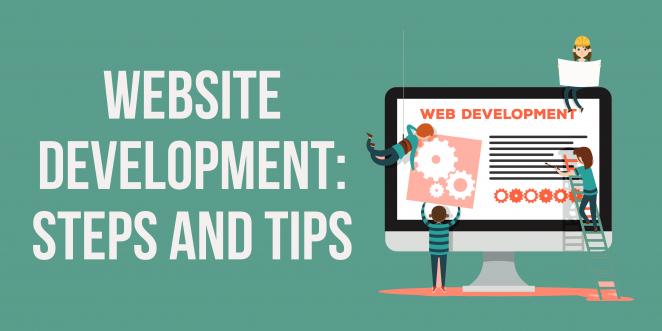Website Development: Steps and Tips
Since the launch of the first website in 1991, the field of website design and development has experienced rapid expansion. Nowadays, any business that wants to flourish needs to have a good website. A website is the best way for customers to learn more about your company. It is the location where your clients will go to contact you and learn more about your business. However, creating a website is not simple.
Building a website entails creating both the front end and the back end, as well as getting a domain name. There is a lot that goes into creating a website that is user-friendly and positively represents your brand. We have therefore put together a guide that will walk you through the website construction process in order to assist you.
What is Website Development?
Website development and website design are the two key phases of website creation. However, it may also involve database management, online publishing, and programming.
While web design explains how a website looks, web development refers to a website functionality. When it comes to creating a website, both abilities are crucial. Even if your website looks stunning and is expertly designed for your brand, it would not be successful if it does not work properly. Also the opposite.
Types of Website Development:
There are several distinct kinds of website development, but front-end development and back-end development are the most typical kinds. This refers to what a user sees and what a user does not see on the page.
Front-End Development:
What the user sees and interacts with on the website is the result of front-end development. The colors, layout, fonts, and images on a website are all examples of website design. If you work as a front-end developer, you are in charge of determining how a website should seem and function.
In front-end development, the website design is created using programs like Photoshop and Illustrator. Additionally, a front-end developer will require knowledge of numerous coding languages, such as HTML, CSS, and JavaScript. It is essential to comprehend these programming languages so that a user may actually interact with the website through buttons and menus.
Back-End Development:
What the user of the website does not see is the back-end development. The back-end development process is more concerned with functionality than aesthetics. This can apply to anything that happens behind the scenes of a website, such as user authentication, network and hosting configuration, database interaction, and more.
A back-end developer is in charge of ensuring that everything on the website functions properly. For instance, a back-end developer is in charge of gathering and analyzing data when users contribute their information to a website. Ruby, Net, and Python are examples of server-side languages that a back-end developer should be knowledgeable about.
Full-stack development is another sort of website development. Both front-end and back-end development can be done by full-stack engineers. A full-stack developer must be proficient in server-side and programming languages and have the ability to manage all facets of website development.
Many firms prefer to hire full-stack engineers because it is obviously a lot simpler to hire one person for the job than it is to hire two people. However, it is a position that is in high demand in the tech sector.
What does the website development process entail?
Every website development process will change, but generally speaking, it will involve the following 8 steps:
Step 1: Information gathering
Before beginning to develop a website, information must be gathered. Here, you will list your purpose, main goals, and target audience.
Essentially, the purpose of creating this website was to help you achieve your objective. Is it to further one own interests or to educate others on a certain topic? To accomplish your goals, you wish to use this website. If you have goals, you will know better how to construct the website and what content to include. Your target market will find your website appealing. Since every business has a target market, make sure to identify it before creating the website. Take into account the age, gender, and interests of your potential client.
Step 2: Planning
You must then start planning your website after gathering the necessary information. Using the information from the first stage, you will create a sitemap. A sitemap lists every topic and subtopic on your website. With the help of the sitemap, you can see the website and how a person would move between pages. If you want to create a user-friendly, visually appealing website, this step is crucial.
Step 3: Design
After the website general layout has been planned, the design must be chosen. Pictures, videos, and other visual content all belong under this category. Consider your target market while you create the layout for your website.
For instance, a brand that targets pet owners will have a very different website than one that targets public relations. Your website should be created with the requirements and preferences of your target audience in mind.
Step 4: Content Creation
The content of a website is one of its most important aspects. Your content will help your readers comprehend your message and convince them to visit your website. Step 2 is essential since it will enable you to clarify your goals and purposes prior to starting to write your content. In order for users to return frequently, your content must be current and intriguing.
Step 5: Functionality
At this point, you will actually start developing your website. At this stage, the aforementioned processes will also combine to create the look and feel of the website. Your website should be easy to use and browse. Usually, the homepage is created first, then each subpage, and so forth. You must also make sure that the website can be accessed from both computers and mobile devices.
Step 6: Testing and Launch
When a website has been effectively constructed, it is not quite ready to go live. It needs to be tested first. Even though testing the website can take some time, it is essential to make sure it is operating properly. This stage involves testing each link and button on the website, checking for good spelling throughout, and making sure the website looks the same on a computer and a phone.
After you have carefully reviewed and tested the website a few times, the exciting stage is to finally launch it. Before becoming life, your website must be uploaded to a server. Immediately after uploading it, you should run one last test to verify sure everything is functioning as it should. Now that the public has access to the
Website Development Tips:
We will provide you with some website development advice so you can really get the hang of it now that you are aware of the many forms of website development and what the website development process comprises.
1. Have a Plan: There is no way for you to know where to start with your website without a plan. Making your website will go a lot more smoothly if you have a plan, resulting in a finished product you can be proud of.
2. Stay Mobile-Friendly: Your website needs to be mobile-friendly because the majority of consumers access the Internet through their smartphones. On a phone screen, your website should appear exactly the same as it does on a laptop screen, just smaller.
3. Make the content easy to read: You need your material to be concise and simple to read because nobody wants to spend more than a few minutes exploring a website. Do not waste your time on filler; just concentrate on using words to make your argument.
4. Use Mailchimp: Be sure to check out Mailchimp if you require assistance with building your own website. With the help of Mailchimp website builder, you can quickly design, personalize, and market a website that represents your business. To develop the website with Mailchimp, you do not need any programming or design skills. We will assist you in doing it.
Conclusion:
Web Solutions Company is one of the leading Website Development Company in Melbourne that can help you enhance your business’s social presence.
If you are looking for a trusted Web Design Company in Melbourne, Web Development Company in Melbourne & Web Development Agency in Melbourne to enhance your social presence including that Instagram, please feel free to call us at +61-403346889 or email us at sales@websolutionscompany.com.au and we'll be more than happy to assist!


